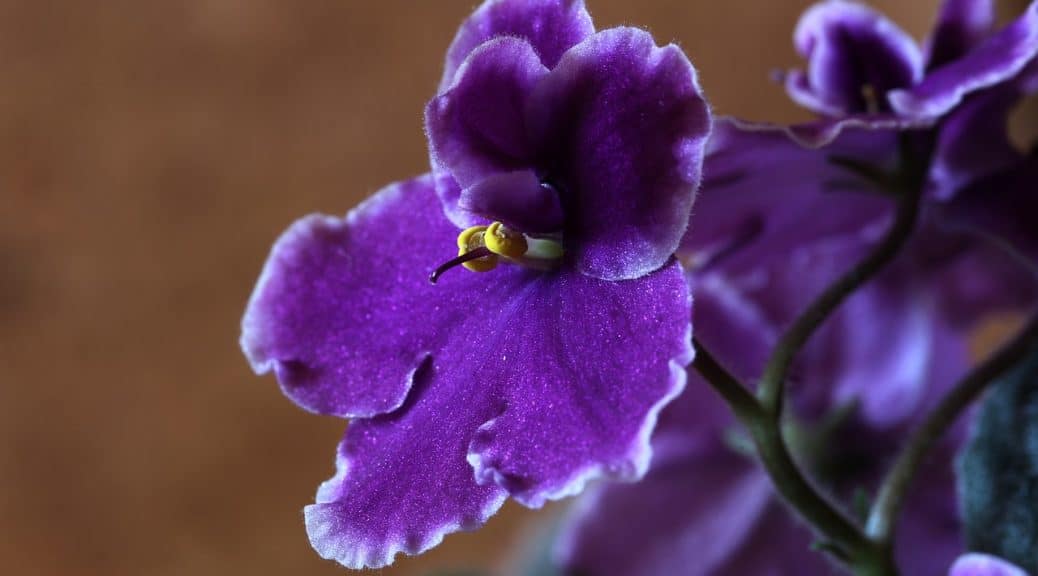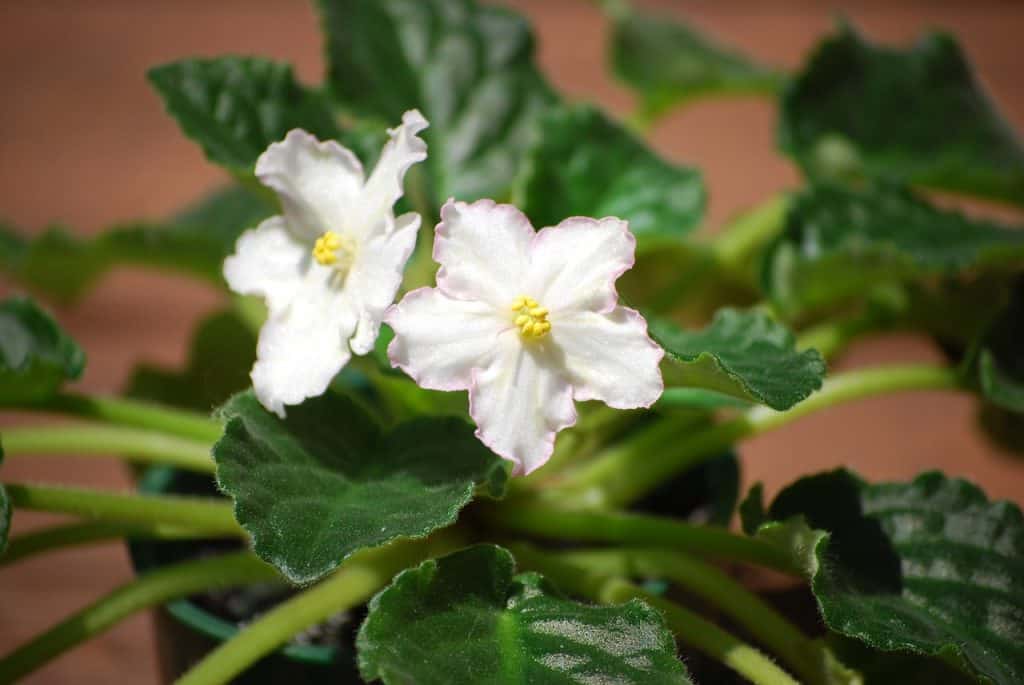
How to Make the Best Soilless Potting Mix for African Violets
Why Use Soilless Potting Mix for African Violets?
You may well ask why you should use a soilless potting mixture for African violets. It is favoured over soil for the following reasons:
- It is challenging to find good topsoil that has no contamination and also has a good supply of all the necessary nutrients.
- Topsoil, once taken from the garden, does not retain its drainage because it is no longer part of the ground drainage system. Once it is in a pot, it packs and becomes water-logged.
- The most significant advantage of a soilless potting mix is its uniformity and your ability to predict how fertiliser will react.
- The components of a soilless potting mix are usually sterilised, and the mix doesn’t have to be pasteurised (a very smelly, messy business) to eliminate any bugs which abound in garden soil and are harmful to African violets.
- Soilless components are abundant and easy to find locally in small quantities.
What to look for in a Soilless Potting Mix for African Violets
Your African violets depend upon you to provide them with a satisfactory environment in which to grow. There are numerous variations in potting mixtures which have been used successfully in growing African violets, but all these mixes have the following characteristics:
- Must be light, porous and drain well
- Does not compact easily
- holds moisture and soluble plant nutrients
- provides organic matter for soil bacteria to feed on
- have slow release plant nutrients
- does not require sterilization or pasteurization
- plant roots can penetrate mix easily
- have a pH between 6.4 to 6.9
The essential characteristic of potting mix is good drainage. It is too late to correct drainage after a plant is potted. Lack of proper drainage is probably the most common reason for poor root growth, root and stem rot, slow leaf growth, and little or no flowering. If your mix doesn’t drain well and isn’t porous, there will be few spaces between particles of the blend for water and air. If spaces fill with water, the mix becomes water-logged and not enough air is supplied to the roots. The plant will begin to die if this condition is not soon corrected. When the mix dries out, spaces fill with air, and the plant lacks water to dissolve and transport soluble nutrients throughout its structure.
The Best Soilless Potting Mix for African Violets
A basic soilless potting mix formula (1-1-1) is one part each of sphagnum peat moss, horticultural vermiculite, and perlite. Another popular mix is (3- 2-1) and there are many more.
Peat moss is recommended because it is coarse, an excellent source of organic matter, decomposes slowly, serves as a reservoir for both water and nutrients, and resists compaction.
Vermiculite and perlite are both coarse, bulky materials that resist compaction and keep the mix loose and well aerated. Vermiculite provides water and nutrient holding capacity and has a high buffering capacity which slows changes in pH. It also permits higher fertilization rates and contains potassium, calcium, and magnesium. Its scaly structure is more easily broken in handling. This can cause compaction and waterlogging.

Perlite doesn’t break up easily but has little capacity to hold nutrients or to buffer pH and has no nutrient value. Perlite is better for aeration. Both vermiculite and perlite are manufactured by heat processes which sterilize them, and they are available in sealed packages that keep them sterile.
Sphagnum peat moss is superior to other types of peat moss which are too fine, compact easily, and get soggy quickly. It is dry, sterile, and packaged to prevent contamination. Peat moss is the mix component which generally contributes most to acidity and has pH varying from 3.5 to 5.5.
Peat moss should be thoroughly wet before being added to the potting mix. This may take several days. If this is not done correctly before potting, the peat moss will be too dry. It is nearly impossible to add enough water to keep it moist and function properly once combined in the potting mix.
When a plant is potted in a mix with peat moss which has not been properly moistened, too much water passes rapidly through the mix and out the bottom of the pot without doing the plant any good. The mix is as dry after watering the plant as before, and the value of fertilizer in the water will be reduced.
To induce peat moss to absorb water, use a neutral wetting agent (surfactant) such as Aqua Soak at a rate of 2 Tbsp. per gallon of hot water. Aqua Soak is neutral (pH 7.0) and is not harmful to plants. Peat moss is placed in a container, Aqua Soak in solution added and peat moss stirred to expedite uptake of water. This process of wetting takes several days and should be completed before peat moss is used in a potting mixture.
If possible test the pH of the sphagnum peat moss before using. This will indicate how much calcium (lime) may have to be added to the potting mixture to raise the pH to between 6.4 and 6.9. Calcium should be in soluble form and finely ground. The finer it is, the better and is quick acting. Use dolomite lime which has magnesium in addition to calcium. Ground limestone (agricultural grade for lawn and gardens) is finely ground and disperses well throughout the mix. Whiting (used in whitewash), and coarse ground eggshells (slow acting) are some examples of calcium.
If the peat moss is too acid — say pH 3.5 – it is challenging to raise the pH to 6.5. Try a different source of peat moss that is not so acid. It took 1 Tbsp. of ground limestone (pH 8.8) to raise 1 cup of peat moss (pH 4.8) to pH 6.3. This reaction was tested with an electronic meter about 15 minutes after being mixed. If this mix with ground limestone added had been allowed to stand for 24 hours before checking, the results would have been better. The pH meter only measures free ions available in solution thus more time would allow the release of more calcium ions to neutralize the acid peat moss ions.
It is recommended a potting mix be allowed to stand for one week before testing and using as more accurate results would be obtained. Usually, one teaspoon of ground limestone per pint of mix should raise the pH to 6.4 to 6.9 if the peat moss is not too acid. Maximum lime should not exceed 1 Tbsp. per gallon of mix, as too much calcium is undesirable.
Use 2 cups of mix (1 pint) when adding lime, to see how much is needed starting with 1/2 teaspoon added to mix when testing for pH. Keep a record of the pH for each increment of lime added thus you can determine how much total lime is needed to raise the pH to the desired level for 1 pint of mix. Then measure the quantity of mix to be treated and figure how much lime has to be added to raise pH to the desired level.
I use Black Magic Potting Mix (pH 6.4) and also Mica Peat (pH 6.2) as the peat moss component in my mix since it requires less lime (calcium) to raise pH to 6.8. Thus a 1-1-1 potting mixture of Black Magic, vermiculite, and perlite would have a pH of about 6.4 without adding any lime.
Charcoal is neutral (pH 7.0) and is added to the mix to neutralize acidity developed later from fertilizer used in watering African violets. To keep the mix from becoming more acid as the peat moss decomposes, water plants twice a month with 1 Tbsp. of dolomite lime per gallon of warm water in place of regular watering. If one tablespoon of dolomite lime is added to the above 1-1-1 potting mixture plus three tablespoons of granular, not powdered, charcoal (when one mix unit is one quart of each component) the pH will be about 6.8.
When you use various components in your potting mixture keep in mind what the component pHs will do to the overall mix pH. Here is a guideline to use but the pH of a material may vary:
- Black Magic (6.4)
- Mica Peat (6.2)
- Redi Earth (4.4)
- Daisy Prep (4.9)
- Coles (6.4)
- Envee (6.8)
- Algit (Norwegian Seaweed 5.0)
- Raw Bonemeal (6.8)
- crushed or ground eggshells (8.6)
- Greensand (potash 3.1)
- Dolomite Lime (8.8)
- Ground limestone (8.8)
Rock Phosphate (9.1) is not recommended as it may cause fluoride toxicity and damage your plants. A good starter mix for African violet leaves or small plantlets is 1 c. Vermiculite, 1 c. Perlite, 2 Tbsp. Charcoal and 1 Tbsp. Dolomite lime.
Emory Bronner’s potting mix is: one 4 qt. bag Black Magic African violet potting mix, one 4 qt. bag Envee African Violet potting soil, 2c. fine charcoal, 1c. bone meal, 1c. dolomite lime, 1c. ground eggshells, 2c. Perlite.
My potting mix is:
- 3 qts. Black Magic AV Potting Soil (pH 6.4), 2 qts. Mica Peat (pH 6.2)
- 1 qt. Vermiculite (medium, pH 7)
- 1 qt. perlite (pH 7)
- 1/2 cups charcoal (pH 7)
- 1 cup ground eggshells (pH 8.6)
- 2 Tbsp. raw bonemeal (pH 6.8)
- 1 Tbsp. greensand (potash – pH 3.1)
- 1 Tbsp. Algit (Norwegian Seaweed pH 5.0)
- 1/8 tsp. FTE (Fritted Trace Elements)
The overall pH of my mix is 6.8.
A soilless potting mix can have slow release plant nutrients added to it. These components are raw bonemeal, greensand, Algit, and 3M Precise timed-release AV food 8-11-5. The above can be used in tiny quantities in potting mix in addition to a regular fertilizer program combined with watering. African violets are light feeders – don’t overdo it and spoil or kill your plants.
Keep your potting mix stored in plastic or metal containers which will keep the mix moist and prevent drying out. Most Club potting mix samples received for testing are much too dried out to be satisfactory for potting an African violet. Potting mix must be moist without being overly wet for best results. Beneficial bacteria in the peat moss need moist conditions in which to work and release nutrients or reduce fertilizer nutrient elements to soluble ions for plant use.

A pH testing kit is convenient for a preliminary check of your mix pH and also after lime has been added to raise pH. If the pH should be on alkaline side (above pH 7.2), you can either add more peat moss or finely ground sulphur.
